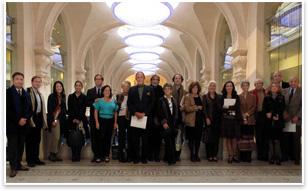MEMBER-TO-MEMBER
Richard Morris Hunt Fellowship Advances International Understanding Through a Love of Historic Preservation
Fellows hold reunion in France
by Mary Brush, AIA, preservation group leader, Holabird & Root
and Wendy Hillis, AIA, historic preservation officer, UNC Chapel Hill
 Summary: Preservation of historic buildings is alive and well in the United States and France, and the Richard Morris Hunt Fellowship is truly one of the most amazing professional fellowships. The laureates are chosen by an international jury for their accomplishments, value to the profession, and potential as future leaders in architectural preservation. The vision of one woman, Michele le Menestrel Ullrich, has awarded 19 laureates and touched the lives of countless people who have supported the supercharged recipients of the prize. It is more than a professional sabbatical. It is six months of inspiration; open doors to leading practitioners; and hands-on understanding of projects, philosophies, and applied techniques. It is a lifetime commitment to the advancement of the profession, as we demonstrated with our recent reunion in France. Summary: Preservation of historic buildings is alive and well in the United States and France, and the Richard Morris Hunt Fellowship is truly one of the most amazing professional fellowships. The laureates are chosen by an international jury for their accomplishments, value to the profession, and potential as future leaders in architectural preservation. The vision of one woman, Michele le Menestrel Ullrich, has awarded 19 laureates and touched the lives of countless people who have supported the supercharged recipients of the prize. It is more than a professional sabbatical. It is six months of inspiration; open doors to leading practitioners; and hands-on understanding of projects, philosophies, and applied techniques. It is a lifetime commitment to the advancement of the profession, as we demonstrated with our recent reunion in France.
Richard Morris Hunt (1827-1895) was the first American architect to study at the Ecole des Beaux Arts. He was a highly influential architect as well as one of the founders of the AIA in 1857. The mission of the fellowship is that as the architects of the two countries studied together, so should the practice of historic preservation be mutually influenced. Architectural preservation transcends physical and cultural boundaries with the Richard Morris Hunt Fellowship.
The program is co-sponsored by the French Heritage Society and the American Architecture Foundation. In alternating years, one French or American architect is welcomed as a visiting professional within offices, job sites, conservation laboratories, and preservation agencies of the U.S. or France. This highly coveted international honor requires applicants to be licensed architects, practicing historic preservation, and conversant in French and English.
Two standout projects
Two buildings visited by our group demonstrate interventions that respect the historic character, space, and materials of a building, all the while valuing the contributions of modern aesthetics and technologies. The first, the Musee des Arts Decoratifs, was designed by Daniel Kahane and our current laureate Diego Rodriguez (RMH 2008). The progressive glazing and lighting details enhance the historic architecture and ornamentation while creating an innovative display of the industrial arts. It is the balance of a museum within a palace, and technological innovation within a historical setting.
A second project influencing modern preservation design in France was the 13th-century Abbey Toussaints in Angers, now the Galerie David d’Angers (architect, Pierre Prunet, 1984). The tensions between old and new, restored and reconstructed are beautifully interconnected with layers of history visibly enhanced by modern design. The original walls are limestone, new walls are brick. A glass-and-steel roof and clear glass windows fill the masonry openings and voids. The slate floor includes a plan of the Romanesque church that predated the 13th-century ruin. The missing elements were not recreated, as their destruction is part of the building’s history. The building has been given new life with a design that is to the highest ability of the technology of the day. Local slate construction techniques were modified in keeping with the local landmark guidelines.
 Different approaches to context Different approaches to context
Context of a historic building is valued differently in the two countries. Anything within 500 meters in all directions from the property line is protected in France. Entire vistas in France are within the domain of a building. This protection of place can be beneficial for the setting and historic character of the immediate surroundings, but it can also create a museum streetscape that hinders the ongoing life of the neighborhood. The U.S. approach limits protection of a historic property to the historic elements unless the building is within a historic district. A negative consequence of the limited boundaries is that the context is lost, and a historic building may be perceived as out of scale with the new construction.
To progress in the craft of architecture, we must know from where we evolved. The ability to continue to evolve is equally important to the presence of history. Discussions among the Fellows provided the inspiration to serve as leaders in the profession, value our association as Fellows, and recognize the unique network we have through the culture of preservation and the rich variety we represent as practitioners in the field.
| 

 Summary:
Summary: Different approaches to context
Different approaches to context